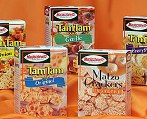 Duly chastened by the Great Tam Tam Crisis of spring ’08, the Manischewitz Company went into overdrive and will have plenty of the crunchy six-sided unleavened crackers available this Pesach season.
Duly chastened by the Great Tam Tam Crisis of spring ’08, the Manischewitz Company went into overdrive and will have plenty of the crunchy six-sided unleavened crackers available this Pesach season.
“Absolutely,” declared the company’s then CEO Bruce Bossidy in November.Bossidy joined the country’s first and still largest matzoh-making concern in January 2008, when Manischewitz was in dire straits. Quality standards weren’t being met, and the 120-year-old kosher manufacturer, a subsidiary of R.A.B. Holdings, was having trouble filling orders. Bossidy spent much of his year with the company cleaning house, bringing in new management, and getting the new matzoh production line up and running at the company’s year-old, $15 million facility in Newark.
But the clock ran down and early last year, Bossidy was forced to cancel Tam Tams for the first time in 68 years.
The outcry was immediate; Jewish consumers coast to coast mourned the absence of the beloved cracker. Stories ran not only in the Jewish media but in The New York Times and New York Daily News, and on NPR. The blogosphere exploded with anger. A black market sprang up, with one Michigan rabbi offering three boxes of the previous year’s crackers on eBay; bidding started at $10.
This April, however, there will be more than enough to go around. All flavors of Pesach Tam Tam crackers will be available except for Tiny Tams, which were not made because of complications with the die cut used to create them. Bossidy also promises a sufficient amount of Pesach matzoh; last year saw shortages of matzoh the Northeast and along the West Coast during the eight-day Yom Tov.
While Manischewitz makes an array of kosher products, it was founded in 1888 as the country’s first commercial matzoh bakery and matzoh remains central to its mission.
Like most kosher food manufacturers, Manischewitz’s busiest season is Pesach. Fifty percent of its business involves kosher-for-Pesach food, particularly matzoh.
At Manischewitz, Pesach matzoh begins its life in a wheat field in one of the Mid-Atlantic states; the exact location is a trade secret. Red winter wheat is the preferred variety for unleavened bread because it is low-protein; protein in the dough produces air pockets that cause it to rise during baking.
The wheat is harvested and brought to another undisclosed location, a family-owned flour mill in rural western Pennsylvania, where it is stored for up to three weeks before being ground into flour. A single wheat kernel moves through the grinding and sifting process in about 20 minutes. The milled flour is kept dry in moisture-resistant bins, usually for no longer than a few days, until it can be transferred to a tanker truck for the three-hour journey to Newark.
Rabbi Yoel Lowenstein, mashgiach at the flour mill for the past four years, has a work schedule that often begins in the middle of the night.
When a newly washed tanker truck arrives at the mill, he crawls inside the enormous steel tank with a flashlight to check for moisture. He runs his hand along the curved sides, peers at the floor, and feels carefully under the jagged metal rim before crawling out and climbing the stairs to the loading platform. The truck pulls up underneath, and Rabbi Lowenstein watches as nearly 50,000 pounds of flour is pumped at high speed into the intake valve on the tanker’s top. At one point Rabbi Lowenstein leaps down and scoops out a few plastic bags of flour, which the driver will carry to Newark to be checked for moisture levels.
When the tanker is full, Rabbi Lowenstein stretches plastic wrap over the 18-inch valve opening to seal it tight, replaces the heavy metal hatch and closes it with a yellow or blue Orthodox Union plastic seal that looks like a large twist tie. Then he runs around to the back of the tanker to place similar plastic seals on the discharge valves, from which the flour will be pumped out. The seals can be removed only by another mashgiach after the truck arrives at the company’s Newark plant. If even one seal is compromised during the journey, so is the flour’s integrity.
A truck carrying Pesach flour to Newark once had a flat tire and the impact blew out one of the seals. The 50,000-pound load had to be discarded.
After the flour arrives in Newark in the early to mid-morning, the mixing and baking process is timed to the second. Rabbi Yaakov Horowitz, longtime head mashgiach at Manischewitz and a worldwide authority on Pesach production, enjoys showing visitors around the plant, pointing out the state-of-the-art matzoh-baking line he helped design.
In the mixing room, Rabbi Horowitz shows the double-kettle system imported from Israel. Flour is dumped down a chute into one kettle before water is added through a thin yellow tube. The mixture is agitated until it forms a sticky dough that is extruded onto a conveyor belt to begin its short run to the ovens.
Five batches of dough are mixed every 14 minutes. Then an alarm sounds, the kettles are rotated automatically and the first kettle is thoroughly cleaned while the process repeats with the second.
Before each batch of dough hits the conveyor belt, one of two mashgichim monitoring the mixing system grabs an egg-sized amount for challah and throws it in a bin for later discarding. The rest of the dough moves over and under a series of metal rollers that press it into thinner and thinner sheets, until the dough is one-fourth of an inch thick. A final perforating roller scores it into matzoh-sized squares and adds tiny holes to keep it flat during baking.
The dough hits the 700-degree oven about 14 minutes after the flour and water are first mixed.
When the matzoh emerges from the oven, it moves through a roller-coaster conveyor belt to cool, is wrapped into cellophane packages and boxed by hand, two packages per box. The boxes are stacked and moved out for delivery.
Manischewitz begins making Pesach matzoh immediately after Labor Day and continues until late February. During the five-month season, up to 20 mashgichim work on the product. This year, for the first time, the factory is using only kosher-for-Pesach flour year-round, even for its daily matzoh. Although the flour is more expensive to produce, it costs the company much less than shutting down the entire plant for four or five weeks every summer for re-kashering. Now the annual kashering takes about a week.
During the height of the Pesach production season, one or two truckloads of flour arrive at the Manischewitz plant every day, about 500,000 pounds a week.
Nearly 76 million sheets of matzoh are produced each year, enough to circle the globe – if one wanted to waste perfectly good matzoh in such a foolhardy way.
{NJ Jewish Standard/Shalom D. & Naomi Amdurski-Matzav.com Newscenter}











